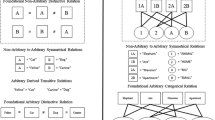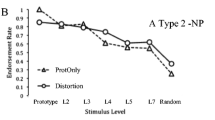Abstract
Individuals with ASD seem to construct categories via processes different to typically developing individuals. We examined whether individuals with ASD engage in structural alignment of exemplars when constructing categories. We taught children with ASD and typically developing children novel nouns for either single or multiple exemplars, and then examined their extensions of the learned nouns to objects that were either a perceptual or conceptual match to the original exemplar(s). Results indicated that, unlike typically developing participants, those with ASD gained no benefit from seeing multiple exemplars of the category and, thus, did not appear to engage in structural alignment in their formation of categories. However, they demonstrated superior performance compared to typically developing children when presented with a single exemplar.



Similar content being viewed by others
References
Arunachalam, S., & Luyster, R. J. (2016). The integrity of lexical acquisition mechanisms in autism spectrum disorder: A research review. Autism Research, 9, 810–828.
Baron-Cohen, S. (2002). The extreme male brain theory of autism. Trends in Cognitive Science, 6, 248–254.
Baron-Cohen, S. (2006). The hyper-systemizing, assertive mating theory of autism. Progress in Neuropsychopharmacology and Biological Psychiatry, 30, 865–872.
Bott, L., Brock, J., Brockdorff, N., Boucher, J., & Lamberts, K. (2006). Perceptual similarity in autism. The Quarterly Journal of Experimental Psychology, 59, 1237–1254.
Carlson, S., & Moses, L. (2001). Individual differences in inhibitory control and children’s theory of mind. Child Development, 72, 1032–1053.
Church, B., Krauss, M., Lopata, C., Toomey, J., Thomeer, M., Coutinho, M., Volker, M., & Mercado, M. (2010). Atypical categorization in children with high-functioning autism spectrum disorder. Psychonomic Bulletin & Review, 17, 862–868.
Clark, E. V. (1973). What’s in a word: On the child’s acquisition of semantics in his first language. In T. E. Moore (Ed.), Cognitive development and the acquisition of language. New York: Academic Press.
Craig, F., Margari, F., Legrottaglie, A. R., Palumbi, R., de Giambattista, C., & Margari, L. (2016). A review of executive function deficits in autism spectrum disorder and attention-deficit/hyperactivity disorder. Neuropsychiatric Disease and Treatment, 12, 1191–1202.
Diesendruck, G., Markson, L., & Bloom, P. (2003). Children’s reliance on creator’s intent in extending names for artifacts. Psychological Science, 14, 164–168.
Dunn, M., & Bates, J. (2005). Developmental change in neural processing of words by children with autism. Journal of Autism and Developmental Disorders, 35, 361–376.
Dunn, M., Vaughan, H., Kreuzer, J., & Kurtzberg, D. (1999). Electrophysiologic correlates of semantic classification in autistic and normal children. Developmental Neuropsychology, 16, 79–99.
Ellawadi, A. B., Fein, D., & Naigles, L. R. (2017). Category structure and processing in 6-year-old children with autism. Autism Research, 10, 327–336.
Fay, W. H., & Schuler, A. L. (1980). Emerging Language in autistic children. Baltimore: University Park Press.
Frith, U. (1989). Autism: Explaining the enigma. Oxford: Blackwell Science.
Frith, U., & Happé, F. (1994). Autism: Beyond ‘theory of mind’. Cognition, 50, 115–132.
Gastgeb, H. Z., Dundas, E. M., Minshew, N. J., & Strauss, M. S. (2012). Category formation in autism: Can individuals with autism form categories and prototypes of dot patterns? Journal of Autism and Developmental Disorders, 42, 1694–1704.
Gastgeb, H. Z., Strauss, M. S., & Minshew, N. J. (2006). Do individuals with autism process categories differently? The effect of typicality and development. Child Development, 77, 1717–1729.
Gentner, D. (1982). A study of early word meaning using artificial objects: What looks like a jiggy but acts like a zimbo? In J. Gardner (Ed.), Readings in developmental psychology. Boston: Little Brown.
Gentner, D. (2003). Why we’re so smart. In D. Gentner & S. Goldin-Meadow (Eds.), Language in mind: Advances in the study of language and thought (pp. 195–235). Cambridge: MIT Press.
Gentner, D., & Markman, A. B. (1997). Structure mapping in analogy and similarity. American Psychologist, 52, 45–56.
Gentner, D., & Namy, L. L. (1999). Comparison in the development of categories. Cognitive Development, 14, 487–513.
Gentner, D., & Namy, L. L. (2006). Analogical processes in language learning. Current Directions in Psychological Science, 15, 297–301.
Gentner, D., Rattermann, M. J., & Forbus, K. D. (1993). The roles of similarity in transfer: Separating retrievability and inferential soundness. Cognitive Psychology, 25, 524–575.
Gershkoff-Stowe, L., & Smith, L. B. (2004). Shape and the first hundred nouns. Child Development, 75, 1098–1114.
Gick, M. L., & Holyoak, K. J. (1983). Schema induction and analogical transfer. Cognitive Psychology, 15, 1–38.
Goldstone, R. L., Medin, D. L., & Gentner, D. (1991). Relational similarity and the nonindependence of features in similarity judgments. Cognitive Psychology, 23, 222–264.
Graham, S. A., Williams, L. D., & Huber, J. F. (1999). Preschoolers’ and adults’ reliance on object shape and object function for lexical extension. Journal of Experimental Child Psychology, 74, 128–151.
Happe, F. (1999). Autism: Cognitive deficit or cognitive style? Trends in Cognitive Sciences, 3, 216–222.
Happe, F., & Frith, U. (2006). The weak central coherence account: Detail-focused cognitive style in autism spectrum disorders. Journal of Autism and Developmental Disorders, 36, 5–25.
Hartley, C., & Allen, M. L. (2014). Generalisation of word-picture relations in children with autism and typically developing children. Journal of Autism and Developmental Disorders, 44, 2064–2071.
Hill, E. (2004). Executive function in autism. Trends in Cognitive Sciences, 8, 26–32.
Imai, M., Gentner, D., & Uchida, N. (1994). Children’s theories of word meaning: The role of shape similarity in early acquisition. Cognitive Development, 9, 45–75.
Jackendoff, R. (1983). Semantics and cognition. Cambridge: MIT Press.
Kelley, E., Paul, J. J., Fein, D., & Naigles, L. R. (2006). Residual language deficits in optimal outcome children with a history of autism. Journal of Autism and Developmental Disorders, 36, 807–828.
Klenberg, L., Korkman, M., & Lahti-Nuuttila, P. (2001). Differential development of attention and executive functions in 3- to 12-year-old Finnish children. Developmental Neuropsychology, 20, 407–428.
Klinger, L. G., & Dawson, G. (2001). Prototype formation in autism. Development and Psychopathology, 13, 111–124.
Landau, B., Smith, L., & Jones, S. (1998). Object shape, object function, and object name. Journal of Memory and Language, 38, 1–27.
Landau, B., Smith, L. B., & Jones, S. S. (1988). The importance of shape in early lexical learning. Cognitive Development, 3, 299–321.
Lord, C., Risi, S., Lambrecht, L., Cook, E. H., Leventhal, B. L., Jr. DiLavore, P. C., Pickles, A., & Rutter, M. (2000). The autism diagnostic observation schedule-generic: A standard measure of social and communication deficits associated with the spectrum of autism. Journal of Autism and Developmental Disorder, 30, 205–223.
Mandler, J. M., & Bauer, P. J. (1988). The cradle of categorization: Is the basic level basic? Cognitive Development, 3, 247–264.
Markman, A. B., & Gentner, D. (1993). Structural alignment during similarity comparisons. Cognitive Psychology, 25, 431–467.
Markman, A. B., & Gentner, D. (1996). Commonalities and differences in similarity comparisons. Memory & Cognition, 24, 235–249.
Markson, L., Diesendruck, G., & Bloom, P. (2008). The shape of thought. Developmental Science, 11, 204–208.
Medin, D. L., Goldstone, R. L., & Gentner, D. (1993). Respects for similarity. Psychological Review, 100, 254–278.
Menyuk, P. (1978). Language: What’s wrong and why. In M. Rutter & E. Schopler (Eds.), Autism: A reappraisal of concepts and treatment (pp. 105–116). New York: Plenum.
Merriman, W. E., Scott, P. D., & Marazita, J. (1993). An appearance function shift in children’s object naming. Journal of Child Language, 20, 101–118.
Minshew, N. J., Meyer, J., & Goldstein, G. (2002). Abstract reasoning in autism: A dissociation between concept formation and concept identification. Neuropsychology, 16, 327.
Mullen, E. M. (1995). Mullen scales of early learning: AGS edition. Circle Pines, MN: American Guidance Service Inc.
Naigles, L. R., Kelley, E., Troyb, E., & Fein, D. (2013). Residual differences with categorical induction in children with a history of autism. Journal of Autism and Developmental Disorders, 43, 2048–2061.
Naigles, L. R., & Tek, S. (2017). ‘Form is easy, meaning is hard’ revisited: (Re) characterizing the strengths and weaknesses of language in children with autism spectrum disorder. Wiley Interdisciplinary Reviews: Cognitive Science. https://doi.org/10.1002/wcs.1438.
Namy, L. L., & Gentner, D. (2002). Making a silk purse out of two sow’s ears: Young children’s use of comparison in category learning. Journal of Experimental Psychology: General, 131, 5–15.
Nelson, K. (1973). Structure and strategy in learning to talk. Monographs of the Society for Research in Child Development, 149, 1–138.
O’Hearn, K., Asato, M., Ordaz, S., & Luna, B. (2008). Neurodevelopment and executive function in autism. Development and Psychopathology, 20, 1103–1132.
Ozonoff, S., Strayer, D. L., McMahon, W. M., & Filloux, F. (1994). Executive function abilities in autism and tourette syndrome: An information processing approach. Journal of Child Psychology and Psychiatry, 35, 1015–1032.
Pickles, A., Anderson, D. K., & Lord, C. (2014). Heterogeneity and plasticity in the development of language: A 17-year follow-up of children referred early for possible autism. Journal of Child Psychology and Psychiatry, 55, 1354–1362.
Plaisted, K. C. (2000). Aspects of autism that theory of mind cannot explain. In S. Baron-Cohen, H. Tager-Flusberg & D. J. Cohen (Eds.), Understanding other minds: Perspectives from developmental cognitive neuroscience. New York: Oxford University Press.
Potrzeba, E. R., Fein, D., & Naigles, L. (2015). Investigating the shape bias in typically developing children and children with autism spectrum disorders. Frontiers in Psychology, 6, 446.
Rosch, E., Mervis, C. B., Gray, W. D., Johnson, D. M., & Boyes-Braem, P. (1976). Basic objects in natural categories. Cognitive Psychology, 8, 382–439.
Samuelson, L. K., & Smith, L. B. (1999). Early noun vocabularies: do ontology, category organization and syntax correspond? Cognition, 73, 1–33.
Schuler, A. L., & Bormann, C. (1982). The interrelations between cognitive and communicative development. In C. E. Johnson & C. L. Thew. In Proceedings of the second international congress for the study of child language. Lanham: University Press of America.
Shulman, C., Yirmiya, N., & Greenbaum, C. W. (1995). From categorization to classification: A comparison among individuals with autism, mental retardation, and normal development. Journal of Abnormal Psychology, 104, 601–609.
Smith, L. B., Jones, S. S., & Landau, B. (1996). Naming in young children: a dumb attentional mechanism? Cognition, 60, 143–171.
Snape, S., & Krott, A. (2018). The role of inhibition in moving beyond perceptually focused noun extensions. First Language, 38, 95–108.
Soulieres, I., Mottron, L., Giguere, G., & Larochelle, S. (2011). Category induction in autism: Slower, perhaps different, but certainly possible. The Quarterly Journal of Experimental Psychology, 64, 311–327.
Soulieres, I., Mottron, L., Saumier, D., & Larochelle, S. (2007). Atypical categorical perception in autism: Autonomy of discrimination? Journal of Autism and Developmental Disorders, 37, 481–490.
Tager-Flusberg, H. (1985a). Basic level and superordinate level categorization in autistic, mentally retarded, and normal children. Journal of Experimental Psychology, 40, 450–469.
Tager-Flusberg, H. (1985b). The conceptual basis for referential word meaning in children with autism. Child Development, 56, 1167–1178.
Tager-Flusberg, H. (2004). Strategies for conducting research on language in autism. Journal of Autism and Developmental Disorders, 34, 75–80.
Tek, S., Jaffery, G., Fein, D., & Naigles, L. (2008). Do children with autism spectrum disorders show a shape bias in word learning? Autism Research, 1, 208–222.
Ungerer, J., & Sigman, M. (1987). Categorization skills and receptive language development in autistic children. Journal of Autism and Developmental Disorders, 17, 3–16.
Wittke, K., Mastergeorge, A. M., Ozonoff, S., Rogers, S. J., & Naigles, L. R. (2017). Grammatical language impairment in autism spectrum disorder: Exploring language phenotypes beyond standardized testing. Frontiers in Psychology, 8, 532.
Acknowledgments
This work was supported by the Economic and Social Research Council.
Author Contributions
SS conceived of the study, collected the data, designed the study, coordinated and drafted the manuscript; AK contributed to the design of the study, interpretation of data, and drafting the manuscript; JPM contributed to the design of the study, interpretation of the data, and drafting the manuscript.
Author information
Authors and Affiliations
Corresponding author
Ethics declarations
Ethical Approval
All procedures performed in studies involving human participants were in accordance with the ethical standards of the institutional and/or National Research Committee and with the 1964 Helsinki declaration and its later amendments or comparable ethical standards.
Informed Consent
Informed consent was obtained from all individual participants included in the study.
Rights and permissions
About this article
Cite this article
Snape, S., Krott, A. & McCleery, J.P. Do Children with Autism Spectrum Disorder Benefit from Structural Alignment When Constructing Categories?. J Autism Dev Disord 48, 2912–2924 (2018). https://doi.org/10.1007/s10803-018-3551-8
Published:
Issue Date:
DOI: https://doi.org/10.1007/s10803-018-3551-8




